The AMD Llano Notebook Review: Competing in the Mobile Market
by Jarred Walton & Anand Lal Shimpi on June 14, 2011 12:01 AM ESTApplication Performance, Round One: PCMark 7
If the battery life was a pleasant change of pace, general application unfortunately remains a weak spot for AMD. Remember that Llano uses a tweaked K10.5 architecture for the CPU portion of the core, and while L2 cache per core is doubled relative to the previous generation quad-core Phenom parts, clock speeds and IPC (instructions per clock) still appear much lower than what Intel offers. I had hoped to see Turbo Core come into play here, which makes the comparison with Toshiba’s A660D a good starting point. That notebook has a Phenom II X4 P920 (quad-core 1.6GHz) with HD 5650M graphics, so the Llano A8-3500M has very similar specs.
Before we get to the graphs, let me make a quick note that not all laptops have been tested in all applications/games. Most of the systems have been shipped back to the manufacturer, so our newer benchmarks are going to have omissions (e.g. PCMark 7). In the gaming charts later in the review, we’ll have even more omissions, and many of the slower GPUs/IGPs will only be tested at our “low” settings.
With that out of the way, let’s start our application performance comparison with PCMark7, our only all-inclusive benchmark for laptops right now. We’ve run all of the benchmarks suites in the hopes of providing a better look at overall performance; however, outside of the “Computation” suite all of the tests have a storage element. That means any system with an SSD (like the quad-core SNB unit) will boast a massive advantage over the competition. The Computation suite also has an interesting footnote in that it supports Intel’s Quick Sync for video encoding, which again gives SNB systems a massive performance advantage. You can read more about the specific suites in PCMark 7 in their whitepaper. We’ll also have two results for Llano going forward: one for using the fGPU (6620G) and a second for using the dGPU (6630M).
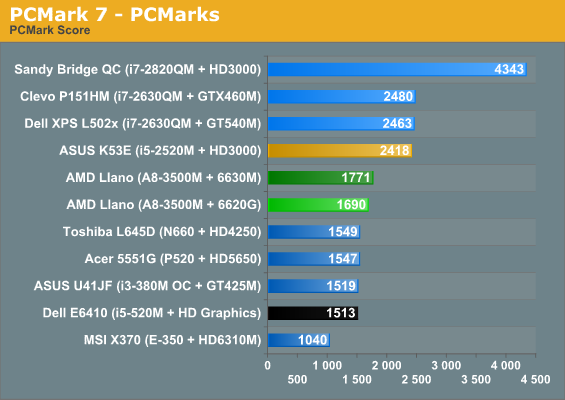
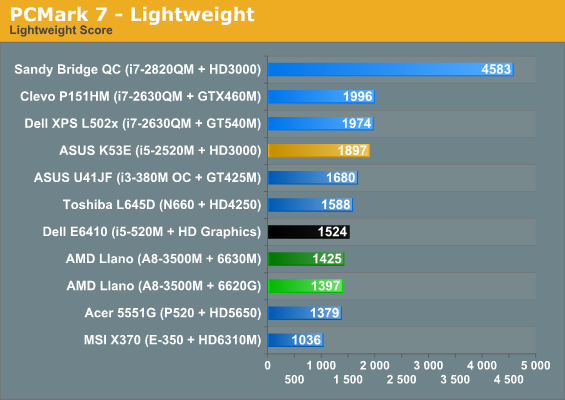
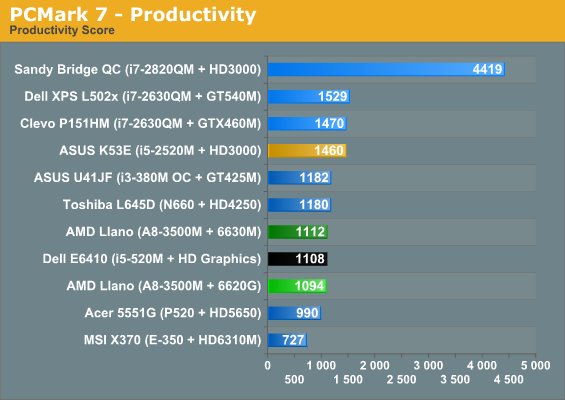

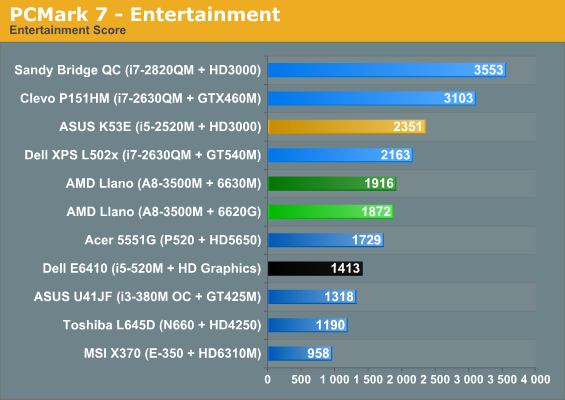
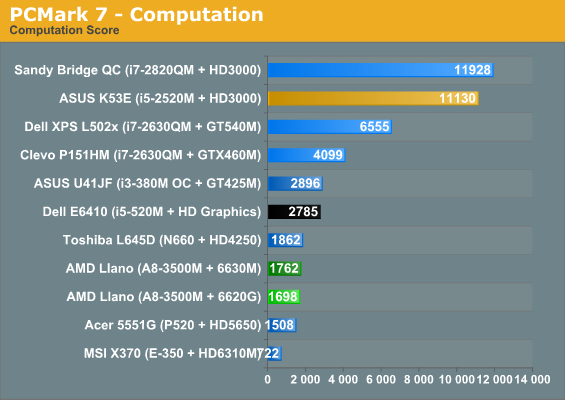
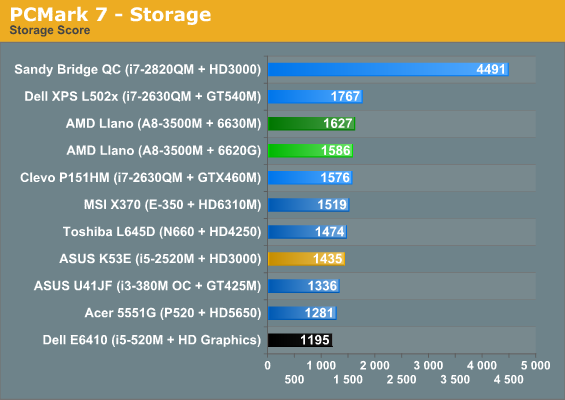
And here’s our first hint that Llano may not be the homerun so many were hoping to see from AMD. All of the SNB laptops are still a healthy step up from Llano in overall PCMarks—the K53E leads by 43%, and systems with quad-core SNB are faster still. Llano might appear to at least surpass the previous generation Arrandale i5-520M in Dell’s E6410, but the storage subsystem in that laptop is a particularly slow 160GB HDD and that skews the results. Then again, the overclocked Arrandale i3-380M in the ASUS U41JF falls short of Llano, so AMD is at the very least competitive with Arrandale.
Since we’re not on a level playing field as far as storage, we won’t comment too much more here, but I do have SSD-based testing complete for four of the notebooks, and once I’ve swapped in an SSD for Llano we’ll have a follow-up article. Let’s move on to application testing round two, where we’ll look at some tests where we eliminate the storage bottleneck.










177 Comments
View All Comments
CyanLite - Tuesday, June 14, 2011 - link
Looks very interesting. Getting one ASAP. Looks like AMD is back.therealnickdanger - Tuesday, June 14, 2011 - link
Yeah, back behind Intel yet again. If the price is right (cheaper than Intel) and the form factor is right (super thin and light notebooks), then I would consider this over SNB. Right now you can get entry-level SNB with medium-quality discrete AMD or NVIDIA graphics for under $700 that will more than match this notebook on GPU performance, battery life, and then proceed to run circles around it in CPU performance. $650 isn't a very good starting point. I hope they work down into that $500-600 bracket soon.Shadowmaster625 - Tuesday, June 14, 2011 - link
I dont get all the talk of $600-$800. There is fundamentally no reason why we wont see these chips in $449 back to school specials, or black friday specials. It is only $50 more in parts vs what we're seeing on slickdeals for $400.For example, this is from today: Lenovo ThinkPad Edge E520 15.6" Notebook Laptop: Core i3-2310M (2.10GHz), 4GB DDR3, 320GB 7200RPM, DVD Super Multi, Intel HD Graphics, HDMI, Win 7 Pro $434 Shipped
That is a $200 ripoff chip from intel. In a $450 notebook deal.
mino - Tuesday, June 14, 2011 - link
Go troll somewhere else.Intel managed to book a bunch of Quad+Discrete while preventing any dual+HD chips in this review providing a fine level of reality distortion field.
But that field does not reality change. Period.
Samus - Wednesday, June 15, 2011 - link
Well considering it will be cheaper than Intel (significantly when considering the additional cost of a comparable $50+ graphics card) and it uses less power than just about any SNB configuration, I think you answered your own questions.8steve8 - Tuesday, June 14, 2011 - link
eh, while this offers modest improvements over sandy bridge in games, the general cpu performance is pretty poor. If gaming is that important to you, then you won't be happy with EITHER IGP, so you'll still be better off with sandy bridge (paired with another gpu).That said, if they were free, I'd buy one. So they could still be a winner in the market if the price is right.
ash9 - Tuesday, June 14, 2011 - link
operative word is mobile - Who number crunches on a laptop anyway?8steve8 - Tuesday, June 14, 2011 - link
well mobile computers are becoming primary machines for many people. It's not just about "crunching numbers" everything non-3d-gaming is limited by storage,cpu, or memory bandwidth. try using a netbook, they aren't a pain to use because of their graphics, storage or memory bandwidth, they suck cause of their cpu performance.duploxxx - Tuesday, June 14, 2011 - link
that is why you probably have an Atom :) perhaps try an E-350 and see how much usable it is in a daily task.Broheim - Tuesday, June 14, 2011 - link
E-350 isn't an improvement over Atom in the CPU department,.